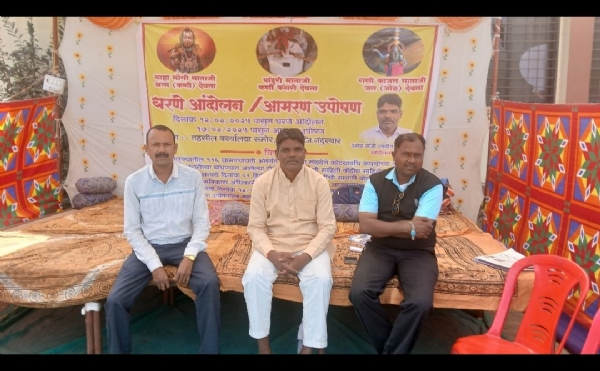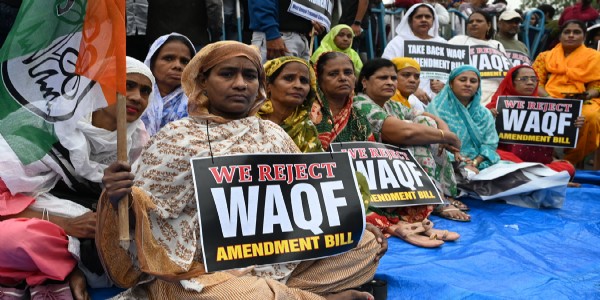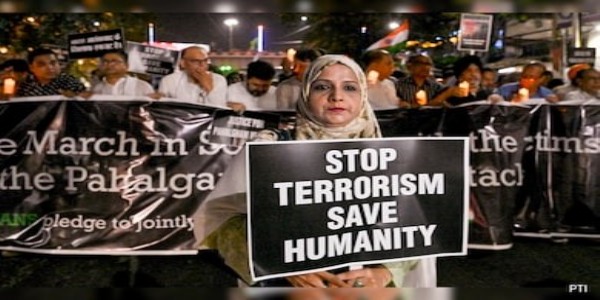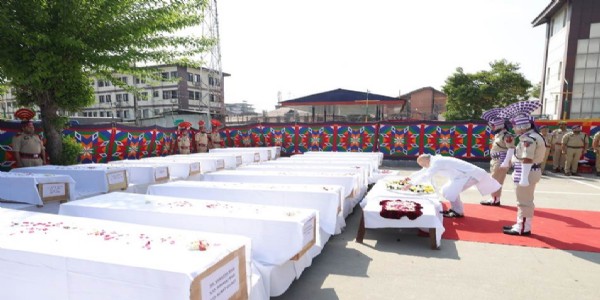Navapur’s tribal lands at risk: Activist Umesh Gavit fights against illegal churches
Total Views |
Navapur taluka of Nandurbar district of Maharashtra is witnessing an alarming transformation — one that raises serious concerns about legality and intent. Over the past 8-10 years, illegal churches worth crores of rupees have sprung up across 116 Gram Panchayats, many encroaching upon tribal lands, uncultivated plots, and even government property.

In a bid to expose the truth, local activist Umesh Manji Gavit filed an RTI request under the Central RTI Act, 2005, on December 9, 2024, demanding key documents, such as the Gram Panchayat resolutions, town planning approvals, and no-objection certificates. However, a disturbing pattern has emerged: officials from all 116 Gram Panchayats, including Gram Vikas Officers and Gram Sevaks, have failed to provide substantial information, raising serious questions about transparency and complicity.
Frustrated by the blatant lack of accountability, Gavit has taken a drastic step – an indefinite hunger strike from February 17 – to force the government to wake up and act.
Gavit sounded an alarm, warning that attempts are being made to mislead and manipulate the tribal community. For generations, the community has been preserving their traditions and culture. But now these forces are exploiting their faith to push religious conversions through deceptive means. He warned that this conspiracy would not go unchallenged. Demanding transparency, he has called on the government to provide official data on both authorised and unauthorised church constructions. The continued silence and lack of response from the authorities, regarding the legality of these constructions, deepens suspension whether they are complicit in any unlawful expansion. Is corruption at play?
Christian missionary presence in Navapur
Navapur has seen a significant rise in Christian missionary activities. There are more than 200 churches and 86 missionary organisations, including that of Protestant, Catholic, and Methodist branches. The presence of Christian missionaries, who are actively engaged in religious conversions, is seen even before India’s Independence, with their earliest activities traced back to the 19th century.
With support from the British, the Team Mission established a church in Chinchpada, Navapur Taluka, marking the beginning of an intensified missionary presence. These missionaries systematically worked to integrate themselves into the tribal communities, particularly among the Bhils. As documented in The Bheel Mission in India by Olof Anton Dahlgren, they employed several strategies to gain the trust of the local population. They learned tribal dialects and Hindi, attended weekly market gatherings, sang hymns, and delivered sermons promoting salvation through Christ. Additionally, they provided medical training, further embedding themselves into the daily lives of the tribals.
By 1907, missionaries reported that more than 10,000 Bhils had come to depend on them for religious guidance. This deep-rooted influence gradually eroded the traditional tribal way of life, causing a major shift in their cultural identity. Indigenous customs, beliefs, and practices, which had been preserved for generations, began to fade under the growing impact of missionary activities.
Among the 86 missionary organisations in Navapur, the prominent ones include:
1. Philadelphia Fellowship Church, Dapur
2. Irish Presbyterian Mission
3. Lalbari Church
4. Shalom Prayer Tower
5. Calvary Seva Sangh Church
6. Fellowship Pentecostal Church Of God
7. FFCI Church
8. Harvest Church India
9. Believers Eastern Church
10. Indian Pentecostal Church of God
11. San Antonio Mission Church
12. Deeside Christian Fellowship Church
13. The Evangelical Alliance Mission
These names indicate how foreign groups are working in this area.
Concerns over tribal demographic changes
The census data from 2001 to 2011 shows that the growth rate of the tribal population in Nandurbar district is the lowest (See Table No. 3). This raises concerns about socio-cultural disruptions caused by religious conversions, leading to shifts in demographic patterns.

There have been multiple instances where churches have served as centres for Christian conversion activities. For example, the Catholic institution in Jashpur has been active for the past 30 years, working under the Joshua Project to convert tribal communities. The project started in the 1990s, and till now thousands of acres of land have been encroached by missionaries and institutions.
A parallel to Arunachal Pradesh?
Such developments pose a significant threat to the tribal identity in Maharashtra, much like the ongoing transformation in Arunachal Pradesh. Between 1991 and 2011, Christianity witnessed the highest rise, increasing from 10% to 30%, while the proportion of Hindus declined from 37% to 29%, and Buddhists from 13% to 11%. This shift has been largely driven by aggressive Christian evangelism, which has rapidly expanded the Christian population, turning Arunachal Pradesh into a Christian-dominated one within just decades.
Therefore, Gavit’s demands call for urgent attention, as they highlight a broader pattern of land encroachment and demographic shifts. While the issue of Land Jihad was already recognised, this situation highlights another form of encroachment, exposing how Christian groups are also occupying Hindu and government land. Moreover, under the guise of charity, foreign-funded missionary groups are exploiting the vulnerabilities of gullible tribals, with false promises of miracles and salvation -- and doing so these indigenous communities are being pulled into an orchestrated web of conversion.
Is this an organised push to strip tribals of their roots? And if so, who is truly behind this shadowy movement? How long will the authorities turn a blind eye to this blatant land grab and systematic conversion drive?

In a bid to expose the truth, local activist Umesh Manji Gavit filed an RTI request under the Central RTI Act, 2005, on December 9, 2024, demanding key documents, such as the Gram Panchayat resolutions, town planning approvals, and no-objection certificates. However, a disturbing pattern has emerged: officials from all 116 Gram Panchayats, including Gram Vikas Officers and Gram Sevaks, have failed to provide substantial information, raising serious questions about transparency and complicity.
Frustrated by the blatant lack of accountability, Gavit has taken a drastic step – an indefinite hunger strike from February 17 – to force the government to wake up and act.
Gavit sounded an alarm, warning that attempts are being made to mislead and manipulate the tribal community. For generations, the community has been preserving their traditions and culture. But now these forces are exploiting their faith to push religious conversions through deceptive means. He warned that this conspiracy would not go unchallenged. Demanding transparency, he has called on the government to provide official data on both authorised and unauthorised church constructions. The continued silence and lack of response from the authorities, regarding the legality of these constructions, deepens suspension whether they are complicit in any unlawful expansion. Is corruption at play?
Christian missionary presence in Navapur
Navapur has seen a significant rise in Christian missionary activities. There are more than 200 churches and 86 missionary organisations, including that of Protestant, Catholic, and Methodist branches. The presence of Christian missionaries, who are actively engaged in religious conversions, is seen even before India’s Independence, with their earliest activities traced back to the 19th century.
With support from the British, the Team Mission established a church in Chinchpada, Navapur Taluka, marking the beginning of an intensified missionary presence. These missionaries systematically worked to integrate themselves into the tribal communities, particularly among the Bhils. As documented in The Bheel Mission in India by Olof Anton Dahlgren, they employed several strategies to gain the trust of the local population. They learned tribal dialects and Hindi, attended weekly market gatherings, sang hymns, and delivered sermons promoting salvation through Christ. Additionally, they provided medical training, further embedding themselves into the daily lives of the tribals.
By 1907, missionaries reported that more than 10,000 Bhils had come to depend on them for religious guidance. This deep-rooted influence gradually eroded the traditional tribal way of life, causing a major shift in their cultural identity. Indigenous customs, beliefs, and practices, which had been preserved for generations, began to fade under the growing impact of missionary activities.
Among the 86 missionary organisations in Navapur, the prominent ones include:
1. Philadelphia Fellowship Church, Dapur
2. Irish Presbyterian Mission
3. Lalbari Church
4. Shalom Prayer Tower
5. Calvary Seva Sangh Church
6. Fellowship Pentecostal Church Of God
7. FFCI Church
8. Harvest Church India
9. Believers Eastern Church
10. Indian Pentecostal Church of God
11. San Antonio Mission Church
12. Deeside Christian Fellowship Church
13. The Evangelical Alliance Mission
These names indicate how foreign groups are working in this area.
Concerns over tribal demographic changes
The census data from 2001 to 2011 shows that the growth rate of the tribal population in Nandurbar district is the lowest (See Table No. 3). This raises concerns about socio-cultural disruptions caused by religious conversions, leading to shifts in demographic patterns.
There have been multiple instances where churches have served as centres for Christian conversion activities. For example, the Catholic institution in Jashpur has been active for the past 30 years, working under the Joshua Project to convert tribal communities. The project started in the 1990s, and till now thousands of acres of land have been encroached by missionaries and institutions.
A parallel to Arunachal Pradesh?
Such developments pose a significant threat to the tribal identity in Maharashtra, much like the ongoing transformation in Arunachal Pradesh. Between 1991 and 2011, Christianity witnessed the highest rise, increasing from 10% to 30%, while the proportion of Hindus declined from 37% to 29%, and Buddhists from 13% to 11%. This shift has been largely driven by aggressive Christian evangelism, which has rapidly expanded the Christian population, turning Arunachal Pradesh into a Christian-dominated one within just decades.
Therefore, Gavit’s demands call for urgent attention, as they highlight a broader pattern of land encroachment and demographic shifts. While the issue of Land Jihad was already recognised, this situation highlights another form of encroachment, exposing how Christian groups are also occupying Hindu and government land. Moreover, under the guise of charity, foreign-funded missionary groups are exploiting the vulnerabilities of gullible tribals, with false promises of miracles and salvation -- and doing so these indigenous communities are being pulled into an orchestrated web of conversion.
Is this an organised push to strip tribals of their roots? And if so, who is truly behind this shadowy movement? How long will the authorities turn a blind eye to this blatant land grab and systematic conversion drive?
Bharati Web






